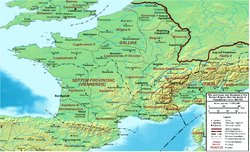This article includes a list of references, related reading, or external links, but its sources remain unclear because it lacks inline citations .(October 2025) |
| Diocese of Gaul Dioecesis Galliarum | |
|---|---|
| Diocese of the Roman Empire | |
| 314–486 | |
 Roman Gaul - AD 400 | |
| Capital | Augusta Treverorum |
| Historical era | Late Antiquity |
• Established | 314 |
• last Roman territory overrun by Franks | 486 |
The Diocese of Gaul (Latin: Dioecesis Galliarum, "diocese of the Gaul [province]s") was a diocese of the later Roman Empire, under the praetorian prefecture of Gaul. It encompassed northern and eastern Gaul, that is, modern France north and east of the Loire, including the Low Countries and modern Germany west of the Rhine.
The diocese comprised the following provinces: Gallia Lugdunensis I, Gallia Lugdunensis II, Gallia Lugdunensis III, Gallia Lugdunensis IV (Senonia), Belgica I, Belgica II, Germania I, Germania II, Alpes Poenninae et Graiae and Maxima Sequanorum.